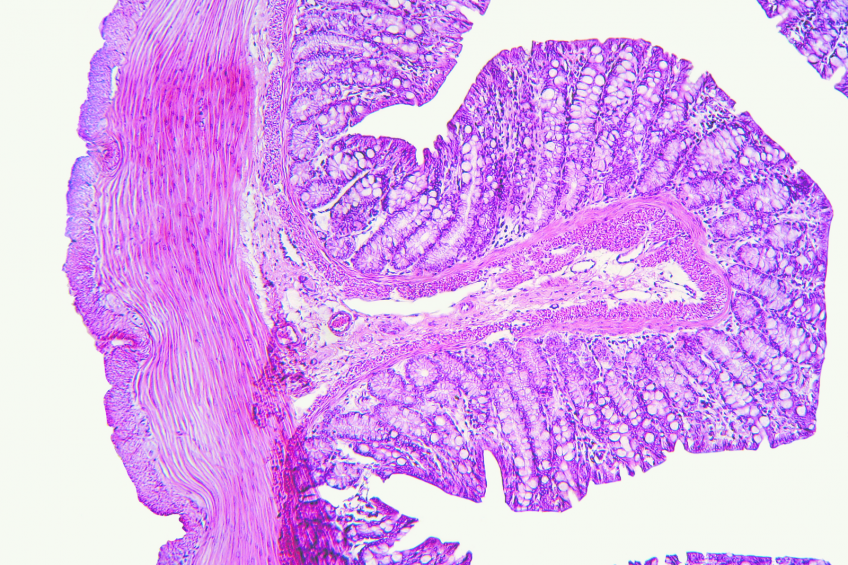Pigs with a healthy intestine perform well

Scientists and veterinarians agree that one single non-antibiotic molecule will have its limits in ?controlling the overall situation. An approach which combines the newest generation butyrate with various additives, however, appears very attractive.
Intestinal health is the most determining factor for health in general, herd performance and eventually farm profitability. Harmful bacteria like E. coli may colonise the gastrointestinal tract, resulting in clinical and sub-clinical diseases. Reduced feed intake and daily gain, inactivity and decreased social interactions are all observed in animals with bacterial infections.
Intestinal health pops up as one of the most important and one of the most complex actions related to animal nutrition. Intestinal health is the sum of intestinal tract functionality and integrity, the established micro-flora and its symbiosis with the host, which is far more important than what nutritionists ever believed.
Surface of intestinal tract
The surface of the intestinal tract is 300 times the size of the surface of the skin. At the same time, it should give a similar level of protection against invaders, while being highly permeable to absorb nutrients. Tight junctions have the major task of closing the cell lines and avoiding paracellular passage of bacteria, toxins and other undesired substances from the lumen to the inside of the body. Several stress factors will have a negative impact on the quality of the tight junctions, leading to the ‘leaky gut’ syndrome by which big sized molecules such as toxins and aggressive radicals are able to pass in between, resulting in cell damage, production of ‘Reactive Oxygen Species’ (ROS) and activation of the immune system. The latter is automatically paired to the production of inflammatory cytokines. The neutralisation of these inflammatory components will consume significant amounts of nutrients, which will be shown in reduced growth and increased feed conversion rates. Although the mode of action of Antibiotic Growth Promoters (AGPs) has not yet been fully understood, there is evidence to believe that, besides regulation of the microflora, AGPs also play an important role in reducing the level of inflammatory cytokines, which results in substantial energy saving and improved performance.
The intestinal microbiome is composed of 1014 microbes originating from more than 500 different species. They supply energy and substrate to the gut wall, prevent colonisation by harmful bacteria and regulate the intestinal immune system.
Usage of AGPs
When the usage of AGPs gained popularity in 1950, this was considered a panacea, a universal remedy to improve (intestinal) health status, performance and economics on the farm. With an increasing use of antibiotics in animal nutrition (of which 60-80% is used to treat intestinal disorders), in 1990 both scientist and public opinion opened the debate on increased bacterial resistance against antibiotics and its eventual transfer to humans. This milestone led to a full ban of AGPs since January 2006 and a significant reduction of antibiotic use in animal feed in many countries of the European Union (EU). Different countries set their targets to reduce antibiotic use in animal feed by 50-70% in the next two to five years. Management and nutrition will certainly have their role to play to achieve these goals.
One can easily understand the complexity of the intestinal system. Many scientists and veterinarians agree that one single non-antibiotic molecule will have its limits in controlling the overall situation.
Lumance, developed three years ago by Innovad’s R&D department, offers a concept and a synergistic approach that ensures a high intestinal health status. The product is a complex structure, containing the newest generation of butyrate, combining slow release and protection technologies, ensuring that acids, medium-chain fatty acids, essential oils, anti-inflammatory compounds and polyphenols are delivered in a gut active way for a powerful and effective antibacterial control, high quality tight junctions and tempering of the inflammatory cytokine production.
Italian trial
In an Italian pig trial, a positive control (500 ppm Amoxicillin, 120 ppm Celestine and 3000 ppm Zinc Oxide) was compared with a negative control (500 ppm Amoxicillin) and a reduced antibiotic treatment (500 ppm Amoxicillin + 1 kg new-generation butyrate). The application turned out to be more economical compared to the positive control. The negative control clearly demonstrates the challenge on the farm by reduced performance, high individual medication treatment and low faecal scoring. The new generation butyrate was able to compensate totally the loss in performance up to the same level as the positive control. Individual antibiotic application was strongly reduced by adding the additive to the diet and faecal scoring was significantly improved compared to the negative control, see Figure 1.
Table 1 shows the results of an academic experimental farm in Lithuania (Lithuanian University of health Science, Veterinary Academy, 2014), 400 piglets (Piétrain x Large White) were divided into two groups. A control diet was compared to a treatment with 1.5 kg/tonne of butyrate from 30 days of age till 60 days of age. Performance was improved in favour of the additive treatment while a clear reduction was observed in gastro-intestinal disorders, see Figure 2.
Maintaining health and performance
The decision to reduce the use of antibiotics in feed, maintaining healthy and well performing animals is not an easy situation to manage. Both management and nutrition should go hand in hand in order to compete with the conventional use of antibiotics. Lumance, being a synergistic concept, has shown to outperform single component feed additives and be a valid alternative for reduced use of antibiotics or single feed additive based performance enhancers, even in the absence of an intestinal challenging situation.






